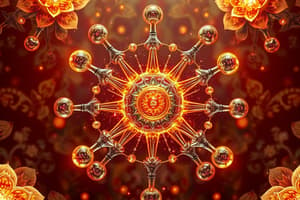Podcast
Questions and Answers
What primarily determines the type of chemical bond formed between two atoms?
What primarily determines the type of chemical bond formed between two atoms?
- The nature of the atoms involved (correct)
- The geographical location of the atoms
- The temperature of the surrounding environment
- The time of day the atoms interact
What is a chemical bond?
What is a chemical bond?
- A force that repels atoms from one another
- A chemical reaction resulting in temperature change
- A force of attraction holding atoms together in a compound (correct)
- A physical arrangement of atoms in space
Which statement is true regarding attractive and repulsive forces in chemical bonding?
Which statement is true regarding attractive and repulsive forces in chemical bonding?
- Attractive forces only occur at large distances between atoms
- Attraction and repulsion forces have no effect on bonding
- Both forces act simultaneously on atoms as they approach each other (correct)
- Repulsive forces are dominant in free atoms
How many elements are recognized in the periodic table?
How many elements are recognized in the periodic table?
What role do valence electrons play in chemical bonding?
What role do valence electrons play in chemical bonding?
What factor is crucial in determining the bonding energy between two atoms?
What factor is crucial in determining the bonding energy between two atoms?
Which of the following describes repulsive forces in atomic interactions?
Which of the following describes repulsive forces in atomic interactions?
What happens to atoms during chemical bonding?
What happens to atoms during chemical bonding?
What occurs when atoms are at the right distance from each other during bonding?
What occurs when atoms are at the right distance from each other during bonding?
Which of the following statements is true regarding valence electrons?
Which of the following statements is true regarding valence electrons?
How does bonding affect the potential energy of charged particles?
How does bonding affect the potential energy of charged particles?
Which law states that mass cannot be created or destroyed during a chemical reaction?
Which law states that mass cannot be created or destroyed during a chemical reaction?
Which of these best describes the law of definite proportions?
Which of these best describes the law of definite proportions?
What is the primary role of attraction and repulsion forces in chemical bonding?
What is the primary role of attraction and repulsion forces in chemical bonding?
When do significant repulsive forces occur between atoms?
When do significant repulsive forces occur between atoms?
Which type of bond forms when atoms share their valence electrons?
Which type of bond forms when atoms share their valence electrons?
What defines a chemical bond?
What defines a chemical bond?
Which statement correctly describes inert elements?
Which statement correctly describes inert elements?
How does the Law of Definite Proportions relate to chemical compounds?
How does the Law of Definite Proportions relate to chemical compounds?
Which of the following best explains the octet rule?
Which of the following best explains the octet rule?
What is represented in a Lewis electron-dot structure?
What is represented in a Lewis electron-dot structure?
What does the Law of Conservation of Mass state?
What does the Law of Conservation of Mass state?
What determines whether elements will lose, gain, or share electrons?
What determines whether elements will lose, gain, or share electrons?
Which of the following is a consequence of bonding energy?
Which of the following is a consequence of bonding energy?
Flashcards are hidden until you start studying
Study Notes
Chemical Bonding and Attractive/Repulsive Forces
- Chemical bonding happens when the attractive forces between atoms balance out their repulsive forces.
- As atoms get closer, attractive and repulsive forces act between them, resulting in a balance at a specific distance.
- This distance where the forces balance is where chemical bonding takes place.
- The interaction between atoms relates to magnets: when magnets are far apart, the forces are negligible, but as they get closer, the forces of attraction and repulsion increase.
- The point before significant repulsion occurs between two magnets is similar to the point where chemical bonding takes place between atoms.
Valence electrons and Chemical Bonding
- Valence electrons are the outermost electrons of an atom.
- When atoms bond together, their valence electrons participate in the formation of chemical bonds.
- Atoms form bonds to achieve stability and lower their chemical energy.
Laws Governing Chemical Bonding
- Law of Conservation of Mass:
- The total mass of the reactants in a chemical reaction is equal to the total mass of the products.
- Mass cannot be created or destroyed, it is only transformed.
- Law of Definite Proportions:
- Atoms of different elements combine in fixed ratios of whole numbers to form compounds.
- The composition of a given compound is always the same.
- Law of Multiple Proportions:
- The same elements can combine in multiple ratios of whole numbers to form different compounds.
Lewis Electron-Dot Symbols and the Octet Rule
- Lewis electron-dot structures represent an element (or ion) by showing its valence electrons as dots arranged around the chemical symbol.
- The octet rule states that molecules attain stability by achieving eight valence electrons.
Studying That Suits You
Use AI to generate personalized quizzes and flashcards to suit your learning preferences.




